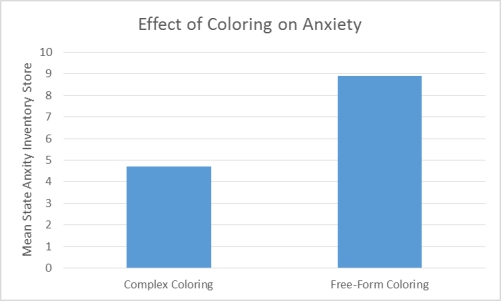Use the following to answer questions
Scenario I
Scenario I is based on fabricated data inspired by the following study:
Curry, N. A. & Kasser, T. (2005) . Can coloring mandalas reduce anxiety? Art Therapy: Journal of American Art Therapy Association, 22(2) 81-85.
Effect of Coloring on Anxiety
Curry and Kasser were interested in examining whether coloring complex geometric patterns reduces anxiety. To that end, they induced anxiety in 84 undergraduate volunteers from their university. Following anxiety induction the participants were divided into two coloring conditions. To determine which condition each participant would be in the researchers put all of their names in a hat. The first name drawn was placed in group 1, the second name drawn was placed in group 2, the third name drawn was placed in group 1, and so on. Those in the complex geometric coloring condition (group 1) were given a paper with a plaid pattern or the outline of a mandala. Those in the control condition (group 2) were given a blank piece of paper. After 20 minutes of coloring all of the participants completed a self-administered State Anxiety Inventory (SAI) . Lower SAI scores indicate low levels of anxiety whereas higher SAI scores indicate high levels of anxiety. The mean SAI scores of each coloring condition were compared to determine whether the type of coloring one does affects anxiety. The results revealed that those who colored a complex geometric pattern had significantly different levels of anxiety than those who colored on a blank sheet of paper. Curry and Kasser concluded that coloring causes a change in anxiety, but only when coloring requires a certain amount of attention and focus.
Figure 1. Effect of Coloring on Anxiety

-(Scenario I) Based on the information provided in Scenario I, which of the following statements BEST describe(s) the data shown in Figure 1?
Definitions:
Present Values
The current worth of a future sum of money or stream of cash flows, given a specified rate of return.
Time Lines
Schedules or timelines outlining the sequence and duration of tasks or events.
Cash Flows
The sum of funds flowing in and out of a company, particularly influencing its ability to cover short-term obligations.
Annuities
Financial products that pay out a fixed stream of payments to an individual, typically used as a retirement strategy.
Q7: Dr.McKay is training research confederates and is
Q11: (Scenario I)Let's say you are skeptical of
Q18: A 2003 study investigating reality-based television programming
Q18: Dr.Pierre just completed an innovative study examining
Q19: Scott is interviewing a nurse about health
Q23: The results of a one-way ANOVA suggest
Q24: Natalia asked her college roommate,"Will becoming a
Q46: Which of the following best addresses the
Q57: Which of the following is an advantage
Q59: _ is the best method of evaluation